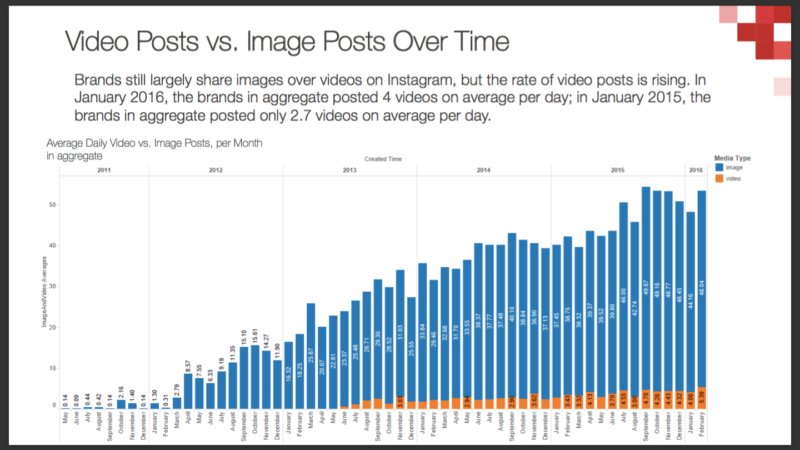Instagram Video Slowly Gains Traction Among Brands After 3 Years
Brands are slowly posting more videos to Instagram, but agency execs still say the Facebook-owned app isn't made for video.
Instagram started letting people post videos in June 2013. In October 2014, it rolled out its first video ads. But even now — nearly three years since the first videos were uploaded to the Facebook-owned app — video is still a new format for brands on Instagram, one that’s growing in interest but limited in adoption.
On average, brands posted 50 percent more organic videos per day in January 2016 than they did in January 2015, according to data collected by video ad-tech firm Pixability. The company analyzed 50 Instagram accounts run by brands including Mercedes-Benz, Bud Light, Pepsi, Skittles, Taco Bell and Ford. But — and it’s a big but — brands are still posting way fewer videos than photos. In January 2016, all of the brands that Pixability examined combined to post, on average, 4.06 videos and 44.16 photos.

Courtesy Pixability
“Instagram really is a ‘look, like and swipe’ platform… People go look at these pictures, like, swipe and move on,” said John Baker, chief data scientist at Pixability.
It’s not like people are against looking at videos on Instagram. The amount of time people spend watching videos on Instagram has increased by more than 40 percent over the past six months, according to an Instagram spokeswoman.
But marketers are slow to see Instagram as a video platform, particularly because Instagram doesn’t really look like a video platform. Instagram is “really designed for a very quick scroll behavior and not taking the time to actually stop and watch something. That’s certainly not an existing behavior,” said Tara Marsh, global head of content at Wunderman, whose clients include United, Best Buy and Coca-Cola.
“With more people spending time on other platforms to watch video like YouTube and Snapchat, I don’t think that’s what they go to Instagram for,” said Jenny Marder, senior social strategist at Red Tettemer O’Connell + Partners, which works with brands like Planet Fitness and MorningStar Farms. “When someone’s going to watch a YouTube video, they’re going to have their headphones on. With Instagram it’s just so easy to scroll through no matter where you are; video adds the aspect of needing to listen to it and pay attention and it’s just an extra step where you lose that sense of something being instant.”
Instagram’s parent company, Facebook, faced the same criticisms early into its own video push, which began to really ramp up in 2014. As of November 2015, Facebook claimed it was generating eight billion video views a day. That’s a squishy number, considering Facebook counts a view after a video has played for at least three seconds, but it’s still a big enough number to suggest Facebook is very much a video platform, despite the fact that videos on Facebook by default play with the sound off, as they also do on Instagram.
But there is a major difference between Facebook’s video experience and Instagram’s. Unlike Facebook — or YouTube or Twitter or Snapchat — Instagram doesn’t let people watch videos in full-screen mode. Instead, the videos are squished into the same area within the feed where photos appear. That means a widescreen video — the type shot to be seen on big screens — typically takes up less than half of the available screen space on Instagram, with no ability to zoom in or tap to expand the shot. That scrunched viewing experience not only hampers brands’ interest in organically posting videos to Instagram but also paying to run those videos as ads.
“If they want to sell a 60-second video ad, it needs to become a much more immersive experience. You see Facebook doing a really good job of that; I’m sure they will bring some of that to Instagram,” said Ms. Marsh. “I don’t think that they will really be able to succeed in driving big dollars on 60-second purchases unless they change that.”
But even if Instagram still isn’t made for watching videos, videos from brands aren’t unwelcome. In fact, the videos brands post to Instagram receive 2.4 times more comments, on average, than their photos — but only half as many likes — according to Pixability.

Courtesy Pixability
It’s unclear exactly why people are more likely to comment on a brand’s Instagram video than a photo, but here are two theories.
First, the more time people spend with a piece of content, the more likely they are to engage with it in a deeper way. “If you watch a video, you’re so invested in it that chances are you’re going to comment on it,” Ms. Marder said. And Ms. Marsh concurred. “If the content is very immersive, then you’re more likely to get to a point where you actually have an opinion on it,” she said.
Second, Pixability’s data could indicate that people are more likely to share videos than photos on Instagram. Instagram didn’t offer a share button for people to send someone else’s photos or videos to friends on Instagram until September 2015. But way before then, people had found a workaround by tagging their friends in the comments of the posts they wanted to share, which would alert those friends to the photo or video that person wanted them to check out. When Instagram added its share button last year, one of its execs told TechCrunch that 40 percent of the comments people leave on photos tagged other users.
Whether or not the comment figures encourage brands to accelerate their adoption of Instagram video — and whether or not Instagram improves the video viewing experience — Instagram appears to be taking a page from its parent company’s playbook to compel brands, publishers and individuals to post videos to its app. Last month, Instagram said it would begin publicly showing how many times a video has been viewed, a move that Facebook took in September 2014 and that may have contributed to the social network’s booming video business. That number could appeal to brands discouraged by the lower number of likes their videos received compared to their photos.
“This is Instagram’s way of providing a metric that they know is naturally going to be higher so that if you say ‘Oh, it didn’t get that many likes but this many people saw it,’ it’s a lot more enticing,” Ms. Marder said.
Contributing authors are invited to create content for MarTech and are chosen for their expertise and contribution to the search community. Our contributors work under the oversight of the editorial staff and contributions are checked for quality and relevance to our readers. MarTech is owned by Semrush. Contributor was not asked to make any direct or indirect mentions of Semrush. The opinions they express are their own.
Related stories
New on MarTech
